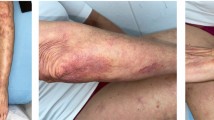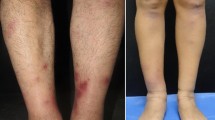Abstract
Pyoderma gangrenosum (PG) is a rare neutrophilic dermatosis that may be caused by an adverse drug reaction. We discuss the clinical presentation and outcomes of 52 cases of drug-induced PG reported to date in the literature. We conducted our literature search for case reports of drug-induced PG using keywords on PubMed and Medical Subject Heading (MeSH) terms on MEDLINE and EMBASE. To assess the probability that each case of PG was related to drug therapy, we used the Naranjo criteria. We identified 44 studies in the literature, with a total of 52 cases of drug-induced PG. The mean Naranjo score for cocaine-induced PG (n = 13) was 9.4, indicating a definite adverse drug reaction, while the mean Naranjo scores for isotretinoin (n = 5), propylthiouracil (n = 5), and sunitinib (n = 5) were 6.2, 6.8, and 7.4, respectively, indicating probable adverse drug reactions. Drugs should be considered as a possible triggering event whenever PG is diagnosed, and clinicians should particularly consider this in patients taking isotretinoin, propylthiouracil, or sunitinib, as well as in patients with a history of cocaine use.
Similar content being viewed by others
References
Crowson AN, Mihm MC Jr, Magro C. Pyoderma gangrenosum: a review. J Cutan Pathol. 2003;30(2):97–107.
Marzano AV, Damiani G, Ceccherini I, et al. Autoinflammation in pyoderma gangrenosum and its syndromic form (pyoderma gangrenosum, acne and suppurative hidradenitis). Br J Dermatol. 2016. doi:10.1111/bjd.15226.
Marzano AV, Fanoni D, Antiga E, et al. Expression of cytokines, chemokines and other effector molecules in two prototypic autoinflammatory skin diseases, pyoderma gangrenosum and Sweet’s syndrome. Clin Exp Immunol. 2014;178(1):48–56.
Wollina U. Pyoderma gangrenosum—a review. Orphanet J Rare Dis. 2007;15(2):19.
Wu BC, Patel ED, Ortega-Loayza AG. Drug-induced pyoderma gangrenosum: a model to understand the pathogenesis of pyoderma gangrenosum. Br J Dermatol. 2016. doi:10.1111/bjd.15193.
Boulenger-Vazel A, Kupfer-Bessaguet I, Gouedard C, et al. Neutrophilic dermatosis associated with propylthiouracil-induced p-ANCA (p-antineutrophil cytoplasmic antibodies). Ann Dermatol Venereol. 2005;132(1):27–31.
Roche E, Martínez-Menchón T, Sánchez-Carazo JL, et al. Two cases of eruptive pyoderma gangrenosum associated with cocaine use. Actas Dermosifiliogr. 2008;99(9):727–30.
Yurci A, Guven K, Torun E, et al. Pyoderma gangrenosum and exacerbation of psoriasis resulting from pegylated interferon alpha and ribavirin treatment of chronic hepatitis C. Eur J Gastroenterol Hepatol. 2007;19(9):811–5.
Naranjo CA, Busto U, Sellers EM, et al. A method for estimating the probability of adverse drug reactions. Clin Pharmacol Ther. 1981;30(2):239–45.
Exner JH, Dahod S, Pochi PE. Pyogenic granuloma-like acne lesions during isotretinoin therapy. Arch Dermatol. 1983;119(10):808–11.
Dasanu CA, Bockorny B, Alexandrescu DT. Pyoderma gangrenosum due to lenalidomide use for multiple myeloma. J Oncol Pharm Pract. 2015;21(6):471–3.
Gangaram HB, Tan LP, Gan AT, et al. Pyoderma gangrenosum following treatment with isotretinoin. Br J Dermatol. 1997;136(4):636–7.
Sagara R, Kitami A, Nakada T, Iijima M. Adverse reactions to gefitinib (Iressa): revealing sycosis- and pyoderma gangrenosum-like lesions. Int J Dermatol. 2006;45(8):1002–3.
Sobieszczańska M, Tubek S, Kura I. Pyoderma gangrenosum-like skin changes after subcutaneous administration of low molecular weight heparin. Hum Vaccin Immunother. 2014;10(4):968–9.
Su WP, Davis MD, Weenig RH, et al. Pyoderma gangrenosum: clinicopathologic correlation and proposed diagnostic criteria. Int J Dermatol. 2004;43(11):790–800.
Akanay-Diesel S, Hoff NP, Kürle S, et al. Sunitinib induced pyoderma gangrenosum-like ulcerations. Eur J Med Res. 2011;16(11):491–4.
Dean SM, Zirwas M. A second case of sunitinib-associated pyoderma gangrenosum. J Clin Aesthet Dermatol. 2010;3(8):34–5.
Levy JM, Richler D, Mahmood MN, Brassard A. Pyoderma gangrenosum associated with alitretinoin therapy. JAAD Case Rep. 2016;2(2):135–7.
Litvinov IV, Sasseville D. Pyoderma gangrenosum triggered by red tattoo dye. CMAJ. 2014;186(12):935.
Jiménez-Gallo D, Albarrán-Planelles C, Linares-Barrios M, et al. Pyoderma gangrenosum and Wegener granulomatosis-like syndrome induced by cocaine. Clin Exp Dermatol. 2013;38(8):878–82.
Pinato DJ, Sharma R. Imatinib induced pyoderma gangrenosum. J Postgrad Med. 2013;59(3):244–5.
Kowalzick L, Bertolini J, Baumann C, et al. Paradoxical reaction to etanercept: development of pyoderma gangraenosum during therapy of psoriasis arthritis. J Dtsch Dermatol Ges. 2013;11(5):447–9.
Stichenwirth M, Riedl E, Pehamberger H, Tappeiner G. Pyoderma gangrenosum in a patient with seronegative rheumatoid arthritis during therapy with adalimumab: toxic effects of adalimumab or failure of adalimumab to prevent the onset of this phenomenon? Arch Dermatol. 2008;144(6):817–8.
Lewerin C, Mobacken H, Nilsson-Ehle H, Swolin B. Bullous pyoderma gangrenosum in a patient with myelodysplastic syndrome during granulocyte colony-stimulating factor therapy. Leuk Lymphoma. 1997;26(5–6):629–32.
Ross HJ, Moy LA, Kaplan R, Figlin RA. Bullous pyoderma gangrenosum after granulocyte colony-stimulating factor treatment. Cancer. 1991;68(2):441–3.
Freiman A, Brassard A. Pyoderma gangrenosum associated with isotretinoin therapy. J Am Acad Dermatol. 2006;55(5 Suppl):S107–8.
Hughes BR, Cunliffe WJ. Development of folliculitis and pyoderma gangrenosum in association with abdominal pain in a patient following treatment with isotretinoin. Br J Dermatol. 1990;122(5):683–7.
Tinoco MP, Tamler C, Maciel G, et al. Pyoderma gangrenosum following isotretinoin therapy for acne nodulocystic. Int J Dermatol. 2008;47(9):953–6.
Darben T, Savige J, Prentice R, et al. Pyoderma gangrenosum with secondary pyarthrosis following propylthiouracil. Australas J Dermatol. 1999;40(3):144–6.
Gungor K, Gonen S, Kisakol G, et al. ANCA positive propylthiouracil induced pyoderma gangrenosum. J Endocrinol Invest. 2006;29(6):575–6.
Hong SB, Lee MH. A case of propylthiouracil-induced pyoderma gangrenosum associated with antineutrophil cytoplasmic antibody. Dermatology. 2004;208(4):339–41.
Seo JW, Son HH, Choi JH, et al. A case of p-ANCA-positive propylthiouracil-induced pyoderma gangrenosum. Ann Dermatol. 2010;22(1):48–50.
Miall FM, Harman K, Kennedy B, Dyer MJ. Pyoderma gangrenosum complicating pegylated granulocyte colony-stimulating factor in Hodgkin lymphoma. Br J Haematol. 2006;132(1):115–6.
Takagi S, Ohsaka A, Taguchi H, et al. Pyoderma gangrenosum following cytosine arabinoside, aclarubicin and granulocyte colony-stimulating factor combination therapy in myelodysplastic syndrome. Intern Med. 1998;37(3):316–9.
White LE, Villa MT, Petronic-Rosic V, et al. Pyoderma gangrenosum related to a new granulocyte colony-stimulating factor. Skinmed. 2006;5(2):96–8.
Mir-Bonafé JM, Blanco-Barrios S, Romo-Melgar A, et al. Photoletter to the editor: Localized pyoderma gangrenosum after interferon-alpha2b injections. J Dermatol Case Rep. 2012;6(3):98–9.
Montoto S, Bosch F, Estrach T, et al. Pyoderma gangrenosum triggered by alpha2b-interferon in a patient with chronic granulocytic leukaemia. Leuk Lymphoma. 1998;30(1–2):199–202.
Park CW, Shin YS, Shin MJ, et al. Pyoderma gangrenosum and spinal epidural abscess after subcutaneous administration of recombinant human erythropoietin. Nephrol Dial Transplant. 1997;12:1506–8.
Nadauld LD, Miller MB, Srinivas S. Pyoderma gangrenosum with the use of sunitinib. J Clin Oncol. 2011;29(10):e266–7.
ten Freyhaus K, Homey B, Bieber T, Wilsmann-Theis D. Pyoderma gangrenosum: another cutaneous side-effect of sunitinib? Br J Dermatol. 2008;159(1):242–3.
Ueharaguchi Y, Kabashima K, Sasahashi M, et al. A case of pyoderma gangrenosum possibly associated with sunitinib treatment. Int J Dermatol. 2013;52(5):634–6.
Usui S, Otsuka A, Kaku Y, et al. Pyoderma gangrenosum of the penis possibly associated with pazopanib treatment. J Eur Acad Dermatol Venereol. 2016;30(7):1222–3.
Jaimes-López N, Molina V, Arroyave JE, et al. Developement of pyoderma gangraenosum during therapy with infliximab. J Dermatol Case Rep. 2009;3:20–3.
Vandevyvere K, Luyten FP, Verschueren P, et al. Pyoderma gangrenosum developing during therapy with TNF-alpha antagonists in a patient with rheumatoid arthritis. Clin Rheumatol. 2007;26(12):2205–6.
Vestita M, Guida S, Mazzoccoli S, et al. Late paradoxical development of pyoderma gangrenosum in a psoriasis patient treated with infliximab. Eur J Dermatol. 2015;25(3):272–3.
Baliu-Piqué C, Mascaró JM Jr. Multifocal and refractory pyoderma gangrenosum: possible role of cocaine abuse. Australas J Dermatol. 2016. doi:10.1111/ajd.12498.
Jeong HS, Layher H, Cao L, et al. Pyoderma gangrenosum (PG) associated with levamisole-adulterated cocaine: clinical, serologic, and histopathologic findings in a cohort of patients. J Am Acad Dermatol. 2016;74(5):892–8.
Keith PJ, Joyce JC, Wilson BD. Pyoderma gangrenosum: a possible cutaneous complication of levamisole-tainted cocaine abuse. Int J Dermatol. 2015;54(9):1075–7.
Tseng E, Alhusayen R, Sade S, et al. Pyoderma gangrenosum secondary to azacitidine in myelodysplastic syndrome. Br J Haematol. 2015;169(4):461.
Kumaresan M, Rai R, Sekar S, Natarajan K. Ciprofloxacin induced pyoderma gangrenosum. Indian Dermatol Online J. 2011;2(2):122–4.
Rudolph BM, Staib F, Von Stebut E, et al. Neutrophilic disease of the skin and intestines after ipilimumab treatment for malignant melanoma—simultaneous occurrence of pyoderma gangrenosum and colitis. Eur J Dermatol. 2014;24(2):268–9.
Author information
Authors and Affiliations
Corresponding author
Ethics declarations
Funding
No funding was received for this study.
Conflict of interest
Jane Y. Wang, Lars E. French, Neil H. Shear, and Afkham Amiri have no conflicts of interest to declare. Afsaneh Alavi has received payment for professional services, including consulting, lecturing and participation in clinical trials, from AbbVie, Galderma, Janssen, LEO, Novartis, Valeant, Boehringer-Ingelheim, Glenmark, Merck Serono, Novartis, Regeneron-Sanofi, Roche, and Xenon; however, these payments do not affect her opinions or conclusions with regard to this submission.
Rights and permissions
About this article
Cite this article
Wang, J.Y., French, L.E., Shear, N.H. et al. Drug-Induced Pyoderma Gangrenosum: A Review. Am J Clin Dermatol 19, 67–77 (2018). https://doi.org/10.1007/s40257-017-0308-7
Published:
Issue Date:
DOI: https://doi.org/10.1007/s40257-017-0308-7




